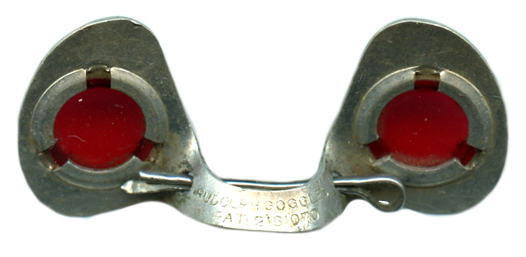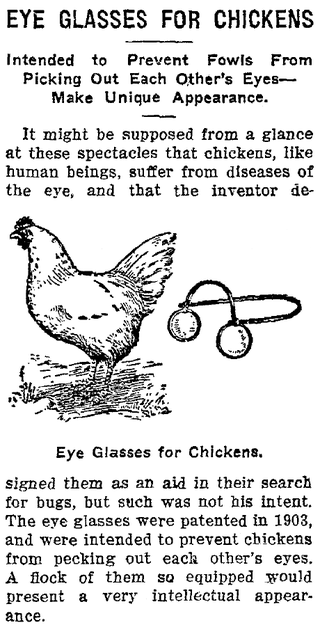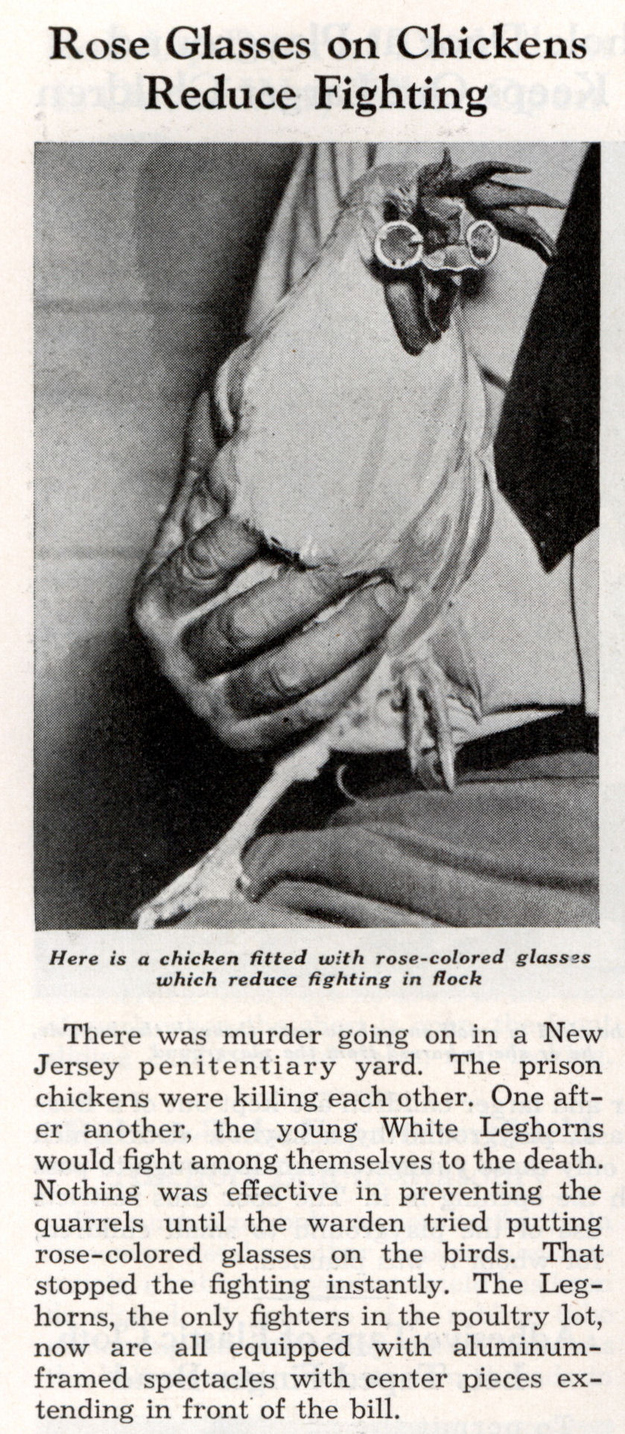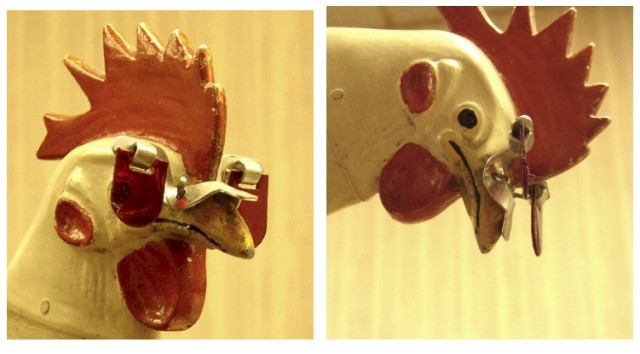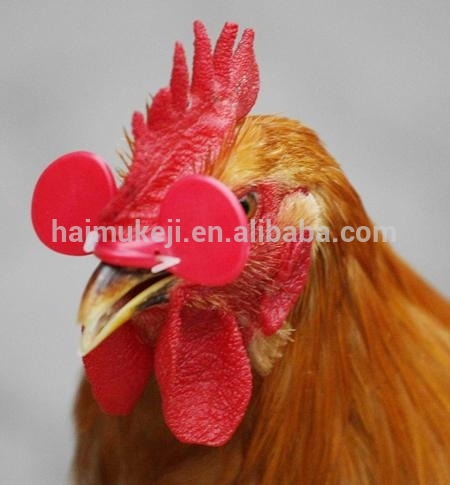Cannibal Chickens Wearing Rose-Tinted Glasses
This is a story of chicken farming, rose-tinted spectacles, and the fight against cannibalism. It’s a rather bleak affair to be honest, but worth knowing about.
In the seedy world of early 20th-century chicken farming, cannibalism was a big deal – and it still is today. Chickens, kept in close quarters, have a tendency to start chowing down on each other.
Once a bird starts getting pecked, it tries to escape, and the fuss that it causes as it flaps about tends to attract more pecking from other birds. Chickens are omnivores, so flesh certainly isn’t off the menu for them. Intense pecking often leads to full-blown cannibalism.
No one is 100% sure why the chickens start pecking at each other, but it’s a well-documented and troublesome phenomenon. Overcrowding is certainly part of the issue, but other factors are also involved; for instance, bright lighting makes the cannibalism worse, as does having injured members in the group; also, groups of chickens that contain a mix of ages and colours or diseased birds seem to experience worse bouts of cannibalism, as do those with barren living quarters.
Although these factors are certainly important, there is still a little mystery involved. Two flocks that are managed in the exact same way might still have polar opposite levels of pecking.
This is bad for the bird’s welfare, of course – no one likes being eaten; but, more importantly (for the farmers), it’s a waste of cash. A stressed bird is not a productive bird, and neither is a dead one. Cannibalism rates can be around 15% in egg-laying flocks kept in aviaries, that’s a large slice of the chicken pie.
How To Prevent Chicken Cannibalism
What’s the solution? Give the birds more space? No, that would cost too much money; perhaps we should stop housing animals in weird situations and eat more plants instead? No, people are too selfish to change their ways like that; no, humans would find a more convoluted way.
Initially, clipping the beak, or debeaking, was found to be an effective intervention. If the beak was blunted or removed, the chickens found it much harder to slaughter their colleagues. However, clipping and debeaking is also time-consuming and distressing for the chicken.
Debeaking is illegal in parts of Australia, Sweden, Finland and Norway; it was eventually banned in Switzerland in 1992, Denmark in 2014, and will have been phased out in Germany by 2017.
So what are we going to do about this rather gruesome issue if debeaking isn’t the answer?
OK, how about tinted sunglasses? I know, I know, that sounds pretty darned bonkers, but someone tried it, and it worked. They tinted tiny little sunglasses a red colour. Yes, that’s right, they gave the chickens rose-tinted specs and they stopped eating each other.
It sounds like I’ve slipped into a fantasy world, but this genuinely happened. The red tint to the glasses prevented the birds from seeing the blood and raw skin on the other birds and reduced the outbreaks of cannibalistic pecking frenzies.
As odd as it sounds, these tinted chicken glasses were not only real, they were popular and effective. By the early 19th century, they were mass produced and sold throughout the US. They were first patented in 1903 by Andre Jackson Sr., in Tennessee.
This from a newspaper in 1911:
And this from an edition of Popular Mechanics in 1938:
Although they were a bit of a fiddle to attach, they were less hassle and less distressing (in general) than debeaking. Some were attached by straps, others by hooking into the nostrils; others still were attached by piercing the septum between the nostrils, but that method is now banned in most countries.
In the early 20th century, rose-tinted chicken specs were widely available from chicken food stores and even via mail order for just a few cents per pair. They also created a hinged version that allows the chicken to peck at the floor without being distracted by the rose colouring. Then, as the bird lifts it head, the lenses fall back into place. Like so:
Although they were still pretty common up until the 1970s, they seem to have fallen out of favour nowadays. They can still be purchased, though, and sometimes, versions like the ones below are used. They’re called blinders, for obvious reasons:
Blinders aren’t as cool as the rose-tinted specs, but prices start from just $0.02 per pair. Not bad, right? At the other end of the spectrum, the vintage pair pictured at the top of this article are on sale for $500! If that’s a little rich, I found these on Ebay for just $14:
It’s relatively difficult to find out what the preferred method of cannibalism-prevention is today, but I think it’s beak-trimming. Farming has become a rather secretive affair; it seems that they would rather hide their strange secrets from the general public. It’s not all farmer’s fault though, they are just supplying our demand, and most of us seem to prefer to hide from the nuts and bolts of the business.
It’s very hard indeed to find any recent images of chickens wearing rose-tinted glasses at all. If you find any, do pass them my way please.
MORE WEIRD ANIMAL STUFF:
AMERICA DESIGNED BAT BOMBS DURING WWII
WHY DO BEARS LOVE HAMMOCKS SO MUCH?
POTOO – NATURE’S MOST SURPRISED LOOKING BIRD

